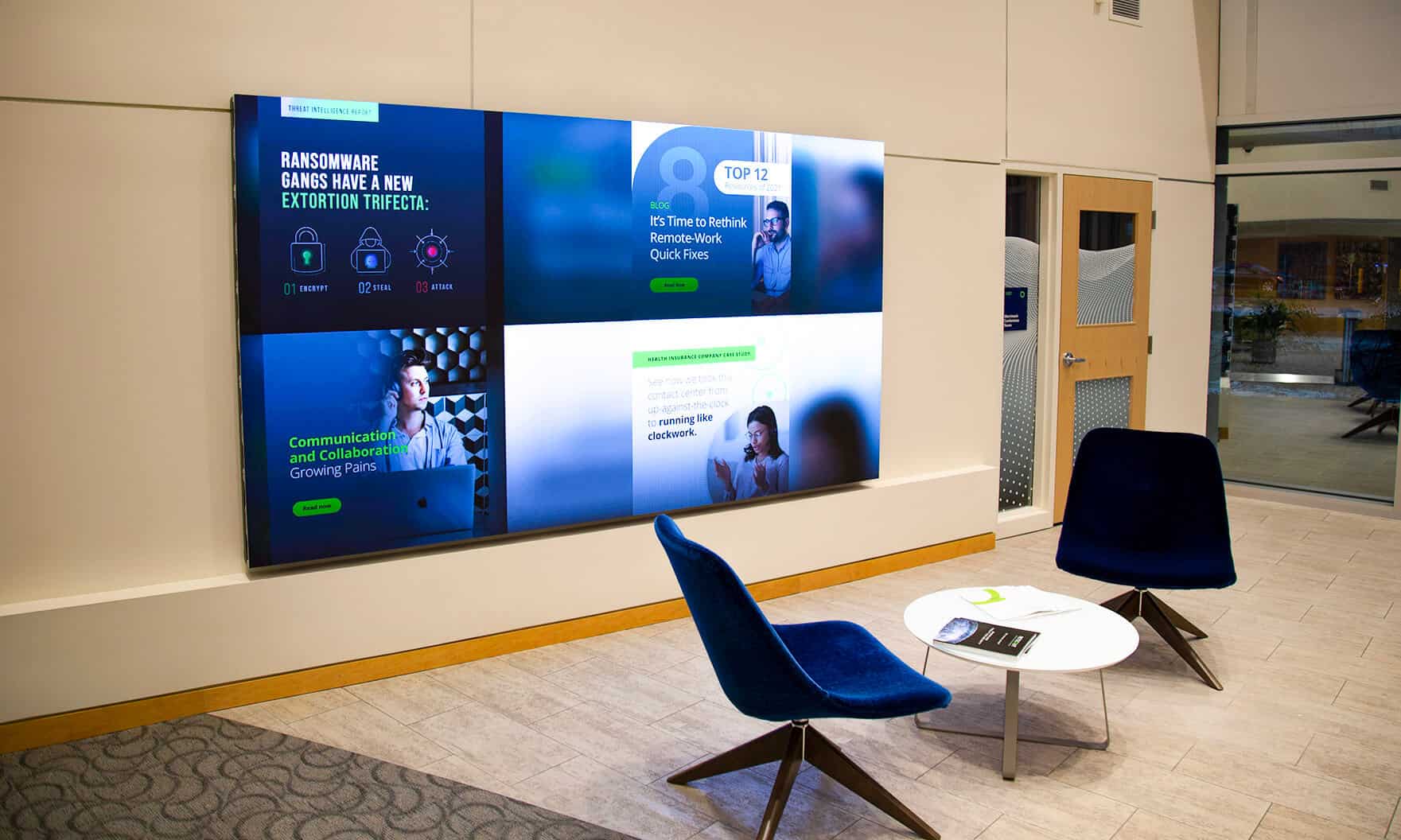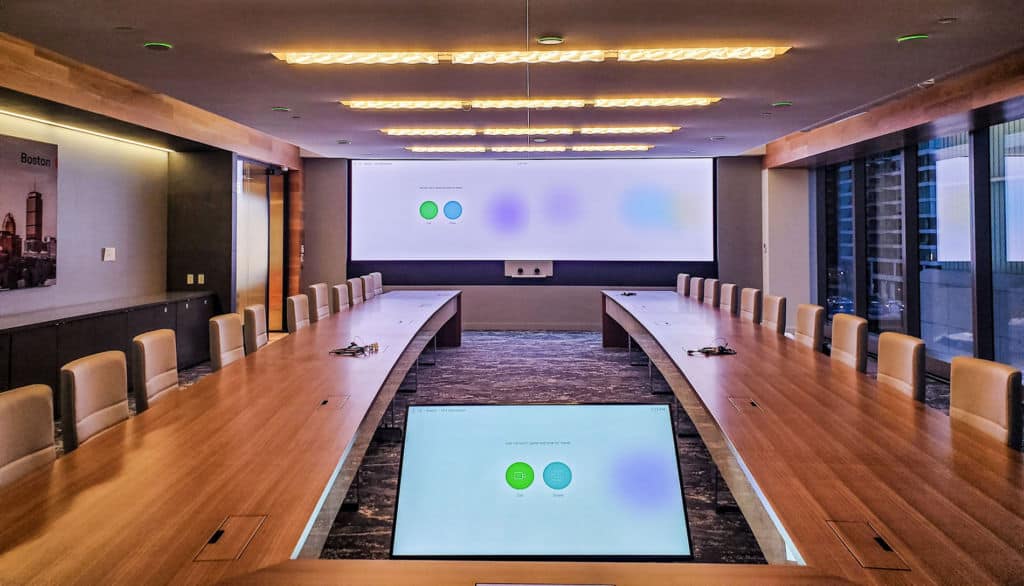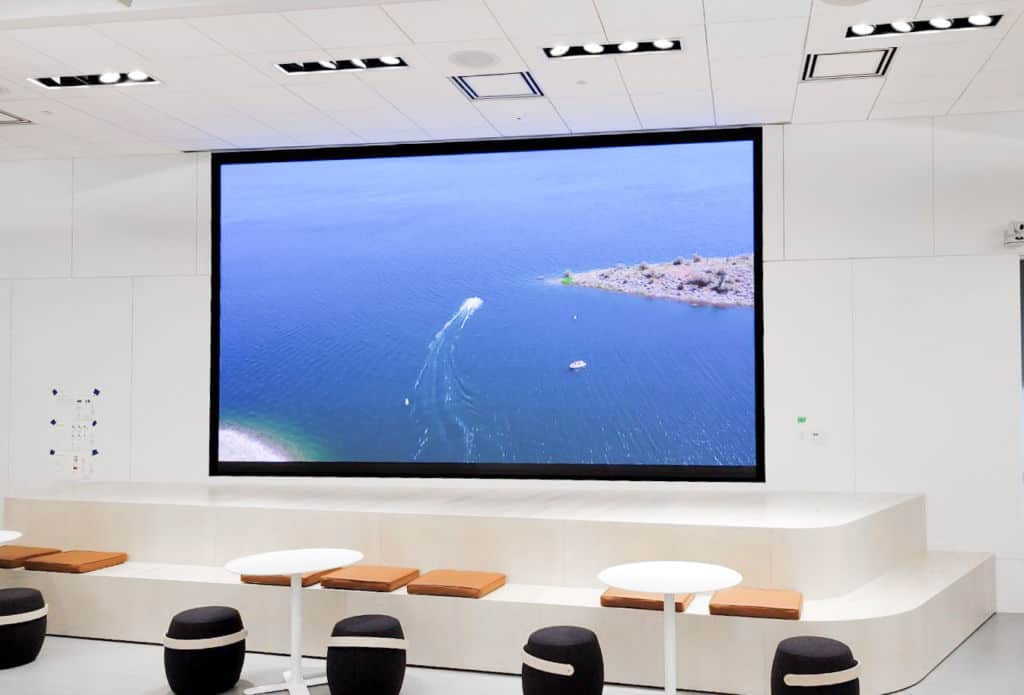Wondering how LED video walls differ from other types of displays? As one of the most cutting-edge types of digital signage, LED technology is a commanding, modern way to bring attention to your business and communicate your message.
Read on to get the details on how this technology works and where it works best!
What is an LED Video Wall?
LED stands for light-emitting diode, which is a semiconductor light source. You may see this technology referred to as “direct view LED.”
This type of flat-panel display consists of tiny lightbulbs that emit colored lights to create full-color pixels that produce an image. LED technology has become more affordable in the last few years, making it more accessible to a wide range of industries and applications.
Since LED panels don’t require bezels (essentially, the frame around the screen), you can tile them together to create a video wall of any size. The modular design means that your display can be the size of a typical TV or as big as a movie screen. They can also be curved, made into unique shapes or transparent.
LED Backlit LCD vs. LED Displays
One of the biggest questions about video walls and displays is what is the differences are between LED Backlit LCD and LED.
The flat panel TVs you normally see in homes and offices are liquid crystal displays (LCD). LCD panels consist of a layer of liquid crystal that’s placed between two pieces of glass. However, liquid crystals are unable to produce their own light, which means backlights(LED) are required behind the glass in order for the display to illuminate.
LED displays are popular because — unlike LCD displays — they can produce and emit light on their own.
Benefits of LED Displays:
- Ideal for indoor or outdoor use
- Low power consumption
- Low maintenance requirements
- Long life spans
- Self-emitting light source
- Available in different shapes and sizes
- High-quality, high-resolution visuals
LED Video Wall Calculator
Discover the custom video wall that fits your needs — and your budget.
How Are LED Video Walls Used?
LED walls can be used pretty much anywhere. If you’ve seen the high-rise hotels in downtown Las Vegas or glanced up at the ceiling in the Boston Museum of Science, you’ve seen some of the most inspiring examples of LED display walls in action.
From large, captivating displays to smaller applications, you’ve likely seen LED walls in the following setting:
- Churches
- Offices
- Amusement park rides
- Art displays
- Simulation systems
LED video walls can connect with your computers, video conferencing equipment, broadcast video systems and other sources so that you can display custom content. You can even create touch-sensitive, interactive displays!
Here are a few ways some of the biggest companies are using LED video walls:
Stanley Black & Decker and Aptiv’s Operation Centers
Stanley Black & Decker has walls that are 20’ and 30’ high, and that serve as a hub for troubleshooting and monitoring at their manufacturing plants. If an assembly line goes down, a video wall can be used to display information or conduct two-way video conferencing to restore processes as quickly as possible. Their LED display walls show 12 images at the same time for three different user groups. Since the walls are incredibly large, they have a high pixel pitch to support the required resolutions.
Global auto parts company Aptiv uses their walls similarly. They monitor all data gathered by their computer systems in their autonomous cars so that operators are able to monitor and troubleshoot situations.
HubSpot’s Lobby/Entry Way Signage
HubSpot wants their visitors to immediately recognize them as technology experts, so an alluring LED video wall was an absolute must-have for their offices. Their display can support nine images at once and is mounted between two vertical I-beams with weight support coming from the floor.
Stanley Hartford’s Outdoor Signage
Stanley Hartford needed a large, bright display that could showcase one logo or image at a time. Their LED video wall is 18’ long and is suspended in the air at around 14’ high. It faces a busy highway and a technology center, making it an eye-catching display to advertise building events and presentations.
Indoor vs. Outdoor LED Video Walls
One of the most impressive features of LED video walls is that they can be designed for indoor and outdoor applications.
Outdoor displays need to meet standard weather ratings, compete with the brightness of the sun and be more structurally sound than indoor displays. The audience for an outdoor display is usually further away than the audience for an indoor display, so they require a lower pixel density. Think of outdoor LED applications as displays on the sides of skyrise buildings in the downtown area of a city.
Indoor LED video walls are usually dimmer with more pixels per square inch (a high pixel density). It’s not uncommon for an outdoor display to be 10x brighter than its indoor counterpart. Since indoor displays are usually twice as bright as the average TV, this is incredibly bright!
How Much Does an LED Video Wall Cost?
Like any other type of customized technology, the price of a LED video wall will depend on a range of factors, like:
- Pixel density (pixels per square inch)
- Overall display size
- Curved, flat or transparent design
- Complexity of installation
- Video processing requirements
- Indoor or outdoor application
- Setup (free standing, ceiling mount or wall mount)
Companies typically budget anywhere between $50k and $350k for their LED video wall project. If you’d like to get an idea of how much your project would cost, you can request a quote here.
Factors to Consider Before Installing an LED Video Wall
Do you think an LED video wall is the next step for you? Before you definitively decide, take the time to consider the following questions:
- Will the display be inside or outside?
- How easy does the system need to be in terms of implementation and maintenance?
- What do you want to display?
- What is your budget?
- How many images do you want to display at once?
- From where will people view your display?
- How much space are you willing to use?
Damage can also be a concern. The higher the pixel density, the less resistant the display is to impact and pressure. You may need to consider methods for protecting the equipment from damage, like mounting it up high or recessing the display.
How to Start Your LED Video Wall Project
Planning, designing and installing your LED video wall is a job that should be handled by professionals who understand both the technological and logistical processes.
DGI can make the LED video wall design and installation process as turnkey as possible for you. We will first identify your project goals, needs and budget. Then, we will conduct planning meetings to gather all the necessary details, including architectural concerns and the project timeline. Once the details have been ironed out, we can get started on creating your display!
Ready to get started? You can contact us here.




